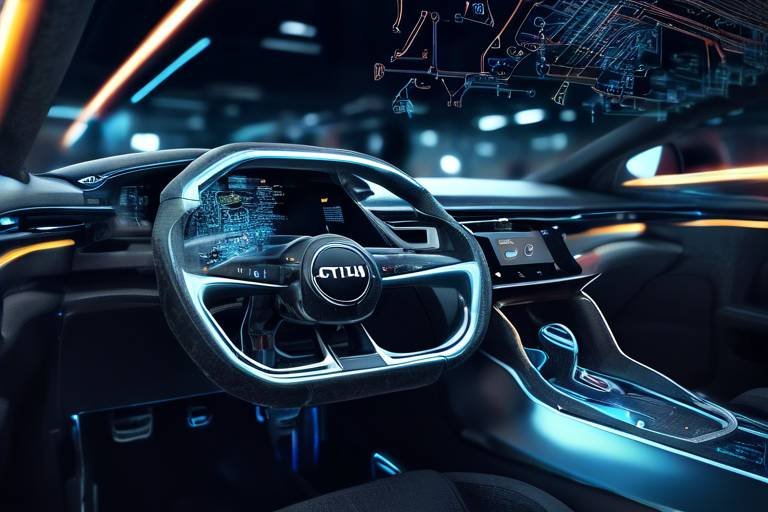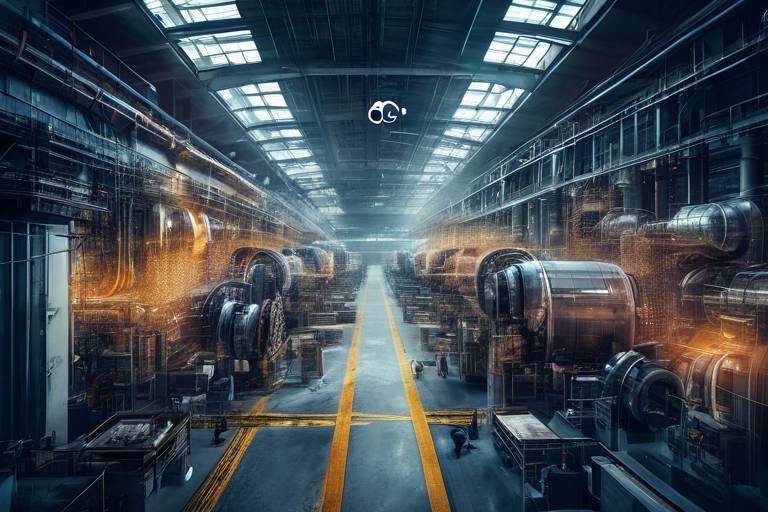Unveiling the Power of AI in Automated Cars
In recent years, the automotive industry has undergone a revolutionary transformation, largely fueled by the advancements in artificial intelligence (AI). Imagine a world where cars not only drive themselves but also learn from their environment, adapt to different driving conditions, and even understand the preferences of their owners. This is not science fiction; it’s the reality of automated vehicles today. As we delve into the fascinating world of AI in automated cars, we will uncover how this technology is not just reshaping vehicles but also redefining the entire driving experience.
AI's impact on the automotive industry is akin to the invention of the wheel—profound and far-reaching. With the integration of AI, cars have evolved from simple machines into sophisticated systems capable of making decisions in real-time. This transformation enhances not only the safety of drivers and pedestrians but also the efficiency of travel, making every journey a seamless experience.
At the heart of this revolution lies a complex interplay of technologies. From advanced driver-assistance systems (ADAS) that prevent accidents to intelligent navigation systems that optimize routes, AI is making vehicles smarter and more responsive. In the following sections, we will explore the evolution of AI in automotive technology, the safety enhancements it brings, and the future it promises for automated cars.
So, buckle up as we embark on this enlightening journey through the world of AI in automated vehicles. Whether you're a tech enthusiast, a car lover, or just curious about the future of transportation, there's something here for everyone. Let’s dive deeper into the evolution of AI in automotive technology and see how far we've come!
AI has not always been a part of the automotive landscape. Its journey began decades ago, with early experiments in machine learning and data processing. Over the years, several key milestones have paved the way for the sophisticated systems we see in cars today. For instance, the introduction of basic autonomous features like cruise control in the 1970s marked the first steps toward automation. Fast forward to the 21st century, and we now have vehicles equipped with deep learning algorithms capable of recognizing objects and making split-second decisions.
As technology has advanced, so has the integration of AI in cars. Today, we see a plethora of features that enhance safety and user experience. From adaptive cruise control to lane-keeping assistance, these technologies work together to create a safer and more enjoyable driving experience. The evolution of AI in automotive technology is not just about making cars smarter; it's about making driving safer and more efficient for everyone on the road.
One of the most significant contributions of AI in the automotive sector is the enhancement of safety. Advanced driver-assistance systems (ADAS) have become a cornerstone of modern vehicles, helping to prevent accidents and protect both drivers and pedestrians. These systems utilize a combination of sensors, cameras, and AI algorithms to monitor the vehicle's surroundings and make real-time decisions.
Imagine driving down a busy street when suddenly a pedestrian steps onto the road. Collision avoidance systems, powered by AI, analyze the situation in milliseconds and can apply the brakes automatically, potentially saving lives. These systems are designed to assess the environment and predict potential hazards, showcasing the critical role of AI in enhancing vehicle safety.
To achieve this level of awareness, various sensor technologies come into play. Cameras, LIDAR, and radar work in tandem with AI to provide comprehensive environmental awareness. This sensor fusion allows vehicles to navigate complex driving scenarios safely, whether it's maneuvering through heavy traffic or navigating tight parking spaces.
Moreover, AI-driven predictive analytics can anticipate potential hazards based on driving patterns. For instance, if a vehicle frequently encounters a specific traffic scenario, the system learns and prepares for it, improving the vehicle's ability to react proactively to changing conditions.
AI is not only about safety; it also significantly enhances the driver experience. Personalized features, intuitive interfaces, and smart navigation make journeys more enjoyable and tailored to individual preferences. Imagine a car that knows your favorite routes, adjusts the climate control to your liking, and plays your favorite music as soon as you get in. This level of personalization is made possible through AI, making each ride not just a commute but an experience.
Now, let's dive into the heart of autonomous vehicles: the algorithms that make self-driving possible. These algorithms are complex and rely heavily on machine learning techniques, allowing vehicles to learn from vast amounts of data and improve their performance over time. The result? Cars that can navigate the streets with minimal human intervention.
Machine learning algorithms play a crucial role in optimizing navigation routes. By analyzing traffic patterns and road conditions, these systems can suggest the most efficient paths, reducing congestion and travel time. Imagine a world where traffic jams are a thing of the past, all thanks to intelligent navigation powered by AI.
Furthermore, real-time decision-making capabilities enable automated cars to respond swiftly to dynamic driving environments. Whether it's a sudden stop by the car in front or a cyclist darting into the street, AI ensures that the vehicle can react promptly, ensuring safety and efficiency in various scenarios.
Looking ahead, the future of AI in automated cars is brimming with potential advancements. Developments in connectivity and smart infrastructure promise to enhance the capabilities of automated vehicles even further. Imagine cars that communicate with each other and with traffic signals, optimizing traffic flow and reducing accidents. The integration of AI with emerging technologies like 5G will enable faster data transmission, allowing vehicles to make even more informed decisions in real-time.
As we continue to explore and innovate, the possibilities for AI in the automotive industry are limitless. The journey towards fully autonomous vehicles is not just about technology; it's about creating a safer, more efficient, and enjoyable driving experience for everyone.
- What is AI in automated cars? AI in automated cars refers to the use of artificial intelligence technologies to enable vehicles to operate autonomously, enhancing safety and user experience.
- How does AI improve vehicle safety? AI improves vehicle safety through advanced driver-assistance systems (ADAS) that help prevent accidents by analyzing surroundings and making real-time decisions.
- What are collision avoidance systems? Collision avoidance systems utilize AI algorithms and sensors to detect potential hazards and prevent accidents by automatically applying brakes or steering the vehicle away from danger.
- What role does machine learning play in navigation? Machine learning analyzes traffic patterns and road conditions to optimize navigation routes, ensuring efficient travel and reducing congestion.
- What advancements can we expect in the future? Future advancements may include enhanced connectivity, smart infrastructure integration, and the use of technologies like 5G to improve real-time decision-making capabilities in automated vehicles.

The Evolution of AI in Automotive Technology
The journey of artificial intelligence (AI) in the automotive industry is nothing short of remarkable. It’s like watching a caterpillar transform into a butterfly—an evolution that has taken decades and is still ongoing. The seeds of AI were planted in the automotive sector as early as the 1950s, but it wasn't until the late 20th century that we began to witness significant breakthroughs. The introduction of basic driver assistance features, such as anti-lock braking systems (ABS) and electronic stability control (ESC), marked the first steps toward integrating AI into vehicles.
Fast forward to the 21st century, and we find ourselves in an era where machine learning and deep learning technologies are revolutionizing how vehicles operate. The development of advanced driver-assistance systems (ADAS) is a prime example of this evolution. These systems leverage AI to enhance driving safety and convenience, paving the way for fully autonomous vehicles. By processing data from various sensors in real-time, AI can make split-second decisions that significantly improve road safety.
One pivotal moment in this evolution was the introduction of the first commercialized AI-driven navigation system in the early 2000s. This innovation not only guided drivers but also learned from their habits, adapting routes based on traffic patterns and personal preferences. It was a game-changer, showcasing the potential of AI to enhance user experience. As we look back, we can pinpoint several key milestones that have shaped the integration of AI in automotive technology:
- 1970s: The first basic cruise control systems were introduced, allowing vehicles to maintain a steady speed without constant driver input.
- 1990s: The development of adaptive cruise control systems, which adjusted vehicle speed based on the distance to the car in front.
- 2000s: Introduction of AI-based navigation systems, enhancing route planning and traffic management.
- 2010s: The rise of fully autonomous vehicle prototypes, with companies like Google and Tesla leading the charge.
As we stand on the brink of the next decade, the automotive industry is witnessing a convergence of AI technologies with other innovations, such as the Internet of Things (IoT) and 5G connectivity. These advancements promise to further enhance vehicle capabilities, offering unprecedented levels of safety, efficiency, and user experience. The evolution of AI in automotive technology is not merely a trend; it’s a fundamental shift that is reshaping how we perceive transportation.
In conclusion, the evolution of AI in the automotive sector is a testament to human ingenuity and technological advancement. With every leap forward, we are inching closer to a future where vehicles can operate independently, safely, and efficiently. As AI continues to develop, we can only imagine the incredible possibilities that lie ahead for automated cars and the broader automotive industry.

Safety Enhancements through AI
When it comes to driving, safety is paramount. With the advent of artificial intelligence, the automotive industry has witnessed a remarkable transformation in how we approach vehicle safety. AI significantly improves vehicle safety by enabling advanced driver-assistance systems (ADAS) that help prevent accidents and enhance overall road safety for both drivers and pedestrians alike. Imagine a world where your car not only navigates the roads but also actively protects you from potential dangers. This is the reality AI is creating.
One of the most exciting developments in this realm is the emergence of collision avoidance systems. These systems utilize sophisticated AI algorithms to analyze the vehicle's surroundings in real-time. They continuously scan for potential hazards, such as other vehicles, pedestrians, and obstacles, making instantaneous decisions to avoid collisions. It's like having a vigilant co-pilot who never blinks! The integration of these systems into modern vehicles showcases the critical role that AI plays in enhancing safety.
Imagine driving down a busy street when suddenly a child darts into the road. Your heart races, and instinct kicks in. But what if your car could react even faster than you? That’s precisely what collision avoidance systems aim to achieve. These systems employ a variety of sensor technologies, including cameras, radar, and LIDAR, to create a comprehensive picture of the environment around the vehicle. By processing this data, the AI can predict potential collisions and take action, whether it’s braking, steering, or alerting the driver.
Various sensors work in tandem with AI to provide comprehensive environmental awareness. For instance, cameras capture visual data, while LIDAR uses laser pulses to map the surroundings in three dimensions. Together, they create a detailed representation of the vehicle’s environment, allowing it to navigate complex driving scenarios safely. This synergy between sensors and AI not only enhances safety but also builds trust in automated driving technologies.
Furthermore, AI-driven predictive analytics can anticipate potential hazards based on driving patterns. By analyzing vast amounts of data from various sources, AI systems can identify trends and make predictions about future road conditions. For example, if the system detects that a particular intersection has a history of accidents during rush hour, it can adjust the vehicle’s route proactively. This proactive approach significantly improves the vehicle's ability to react to changing conditions, ultimately leading to safer driving experiences.
In conclusion, the integration of AI in safety enhancements is not just a technological advancement; it’s a leap towards a future where road safety is prioritized. As we continue to embrace these innovations, the dream of accident-free driving becomes more attainable. The combination of collision avoidance systems, advanced sensor technologies, and predictive analytics is paving the way for a safer, more efficient driving experience.
- How do collision avoidance systems work? Collision avoidance systems use AI to analyze real-time data from various sensors to detect potential hazards and make split-second decisions to avoid collisions.
- What types of sensors are used in automated cars? Automated cars typically use a combination of cameras, radar, and LIDAR to gather data about their surroundings.
- Can AI predict accidents before they happen? Yes, AI can analyze driving patterns and environmental data to anticipate potential hazards, allowing for proactive safety measures.

Collision Avoidance Systems
When it comes to the safety of automated vehicles, are nothing short of revolutionary. Imagine driving down a busy street, and suddenly, a pedestrian steps onto the road. In the blink of an eye, your car analyzes the situation, calculates the best course of action, and avoids a potential accident. This is the magic of AI-powered collision avoidance systems at work. These systems utilize sophisticated AI algorithms that continuously monitor the vehicle's surroundings, making real-time decisions that enhance safety for both drivers and pedestrians.
At the heart of these systems is the ability to process vast amounts of data from various sensors. The integration of cameras, radar, and LIDAR technologies allows vehicles to build a detailed picture of their environment. For instance, while a camera captures visual data, LIDAR uses laser light to measure distances, providing a three-dimensional view of obstacles. Together, these sensors create a comprehensive awareness that is crucial for safe navigation.
Furthermore, collision avoidance systems are not just about reacting to dangers; they are also about predicting them. By leveraging predictive analytics, these systems can analyze driving patterns and environmental conditions to foresee potential hazards. For example, if a car ahead suddenly brakes, the system can detect this change and prepare to engage the brakes, reducing the likelihood of a rear-end collision. This proactive approach is akin to having a co-pilot who not only reacts but also anticipates challenges on the road.
To illustrate the effectiveness of collision avoidance systems, consider the following table that highlights some key features and their benefits:
| Feature | Benefit |
|---|---|
| Real-time Object Detection | Immediate identification of obstacles, allowing for quick responses. |
| Automatic Emergency Braking | Reduces impact severity or avoids collisions altogether. |
| Lane Departure Warning | Alerts the driver if the vehicle unintentionally drifts out of its lane. |
| Adaptive Cruise Control | Maintains a safe distance from the car ahead, adjusting speed as necessary. |
In summary, collision avoidance systems represent a significant leap forward in automotive safety technology. By merging AI with advanced sensor technologies, these systems not only enhance the driving experience but also protect lives on the road. As we continue to embrace this technology, we can look forward to a future where accidents become increasingly rare and road safety becomes a shared responsibility between humans and machines.
- What are collision avoidance systems?
Collision avoidance systems are technologies that help prevent accidents by detecting obstacles and making real-time decisions to avoid collisions. - How do these systems work?
They use a combination of sensors, including cameras, radar, and LIDAR, to monitor the vehicle's surroundings and analyze data with AI algorithms. - Can collision avoidance systems prevent all accidents?
While they significantly reduce the likelihood of accidents, they cannot guarantee complete prevention, as various factors, including human behavior, can influence outcomes. - Are collision avoidance systems standard in all automated vehicles?
Not all automated vehicles come equipped with these systems, but they are becoming increasingly common as safety regulations evolve.

Sensor Technologies
In the realm of automated vehicles, play a pivotal role in ensuring safety and efficiency. These sophisticated devices are the eyes and ears of autonomous cars, providing them with the necessary data to navigate complex environments. Imagine driving through a bustling city or cruising down a winding country road; the ability of a car to react appropriately in real-time is largely dependent on its sensors.
Among the most important sensor technologies are cameras, radar, and LIDAR. Each of these sensors has unique functionalities that contribute to the overall performance of automated vehicles:
- Cameras: These devices capture high-resolution images and video of the vehicle's surroundings. They are essential for recognizing traffic signs, lane markings, and detecting pedestrians and cyclists. Advanced image recognition algorithms analyze the visual data to make informed decisions.
- Radar: Radar sensors use radio waves to detect the speed and distance of objects around the vehicle. They are particularly useful in adverse weather conditions, such as rain or fog, where visibility might be compromised. Radar can effectively track moving objects, making it invaluable for collision avoidance systems.
- LIDAR: Standing for Light Detection and Ranging, LIDAR utilizes laser beams to create a 3D map of the environment. This technology provides precise distance measurements and is crucial for understanding the vehicle's surroundings in real-time. The detailed information gathered allows for accurate navigation and obstacle detection.
When these sensor technologies work in harmony, they create a comprehensive awareness of the vehicle's environment. For instance, while the cameras identify and classify objects, the radar can gauge their speed and direction, and the LIDAR can map out the terrain in three dimensions. This synergy is what enables automated vehicles to make split-second decisions that can prevent accidents.
Moreover, the integration of these sensors with artificial intelligence enhances their capabilities even further. AI algorithms can process the vast amounts of data collected by these sensors, learning from various driving scenarios to improve decision-making processes over time. This means that as automated vehicles accumulate more experience on the road, they become increasingly proficient at navigating complex situations.
As we look to the future, advancements in sensor technologies will continue to evolve. Innovations such as thermal imaging sensors and ultrasonic sensors are on the horizon, promising to further enhance the capabilities of automated vehicles. These developments will not only improve safety but also contribute to a more seamless driving experience for users.

Predictive Analytics for Safety
Imagine driving down a busy highway, and suddenly, the car alerts you to a potential hazard ahead, allowing you to react before the situation escalates. This isn't just a futuristic dream; it's the power of predictive analytics at work in automated vehicles. By leveraging vast amounts of data collected from various sensors and driving patterns, AI systems can anticipate potential hazards even before they occur. This capability is not merely a convenience; it significantly enhances safety for both drivers and pedestrians.
Predictive analytics operates by analyzing historical data to identify patterns that may indicate future risks. For example, if a vehicle's AI system recognizes that a particular intersection frequently experiences accidents due to poor visibility, it can alert the driver or even adjust the vehicle's speed and trajectory to navigate the area more safely. This proactive approach is akin to having a co-pilot who not only reacts to the current conditions but also predicts and prepares for what lies ahead.
To further illustrate how predictive analytics functions in enhancing safety, consider the following key components:
- Data Collection: Automated vehicles gather data from various sources, including GPS, weather conditions, and traffic patterns. This data is crucial for understanding the driving environment.
- Machine Learning Algorithms: These algorithms analyze the collected data to identify trends and predict potential hazards. They learn from past incidents to improve their accuracy over time.
- Real-Time Alerts: When a potential hazard is detected, the system can issue real-time alerts to the driver, allowing for timely interventions.
Furthermore, the integration of predictive analytics with other safety technologies, such as collision avoidance systems and adaptive cruise control, creates a multi-layered safety net. For instance, if the system predicts that a car is likely to brake suddenly ahead, the vehicle can preemptively adjust its speed, reducing the risk of collision. This synergy between different technologies exemplifies how AI is revolutionizing road safety.
In conclusion, predictive analytics is not just a buzzword; it is a transformative tool that enhances the safety of automated vehicles. By anticipating potential dangers and enabling proactive measures, AI systems are paving the way for a safer driving experience. As technology continues to evolve, we can expect even more sophisticated predictive capabilities that will further protect us on the roads.
- What is predictive analytics in automated cars? Predictive analytics involves using data and algorithms to anticipate potential hazards and improve safety in automated vehicles.
- How does predictive analytics enhance safety? By analyzing historical data and recognizing patterns, predictive analytics can alert drivers to potential risks before they occur, allowing for timely reactions.
- Can predictive analytics work with other safety technologies? Yes, it can integrate with systems like collision avoidance and adaptive cruise control, creating a comprehensive safety framework in automated vehicles.

Driver Experience and Comfort
When it comes to driving, comfort and experience are everything. Imagine sliding into your car and being greeted by a system that knows your favorite playlist, adjusts the seat to your preferred position, and sets the climate control just the way you like it. This is not just a dream anymore; it’s the reality that artificial intelligence (AI) is bringing to automated vehicles. By integrating personalized features, AI transforms the driving experience into something uniquely tailored for each individual.
One of the most exciting aspects of AI in automated cars is the use of intuitive interfaces. These interfaces are designed to be user-friendly, allowing drivers to interact with their vehicles in a way that feels natural and engaging. Whether it’s through voice commands or touchscreens, the technology is evolving to make our interactions with cars more seamless. For instance, imagine telling your car, “Take me to my favorite coffee shop,” and it not only knows where to go but also suggests the best route based on real-time traffic data. This level of integration makes driving not just a necessity but an enjoyable experience.
Moreover, AI enhances navigation systems to become smarter and more efficient. Gone are the days of getting lost or stuck in traffic. With advanced algorithms that analyze traffic patterns and road conditions, automated vehicles can optimize routes dynamically. This means less time spent in traffic and more time enjoying the journey. It’s like having a personal assistant who not only knows your preferences but also is always one step ahead of the game.
Another significant benefit of AI in automated cars is the ability to offer adaptive learning. As the vehicle learns from your driving habits, it can make suggestions that enhance comfort and safety. For example, if you typically drive during rush hour, the AI can adjust your routes to avoid congestion, or if you prefer a smoother ride, it can modify the suspension settings based on your driving style. This adaptability creates a driving experience that feels personalized and responsive, almost as if the car is a companion rather than just a mode of transport.
Furthermore, AI can enhance the overall atmosphere within the vehicle. Imagine a scenario where your car senses your mood through biometric feedback and adjusts the lighting, music, and even the scent inside the cabin to create a relaxing environment. This level of comfort is not just about luxury; it’s about creating a holistic experience that caters to the driver’s emotional and physical needs.
In summary, the integration of AI in automated cars is revolutionizing how we experience driving. From personalized settings to adaptive learning and intuitive interfaces, these technological advancements are designed to make every journey not just a trip from point A to B, but a comfortable and enjoyable experience. The future of driving is not just about getting there; it's about how you feel along the way.
- How does AI improve driver comfort in automated cars?
AI personalizes settings such as climate control, seating position, and entertainment options based on individual preferences. - What role does navigation play in enhancing the driving experience?
AI optimizes routes in real-time, helping drivers avoid traffic and reach their destinations more efficiently. - Can AI learn from my driving habits?
Yes, AI can adapt to your driving style and make suggestions to improve comfort and safety. - What is the future of AI in enhancing driver experience?
Future advancements may include even smarter interfaces, better predictive capabilities, and integration with other emerging technologies.

Autonomous Driving Algorithms
When we think about the magic behind automated cars, the term often comes to mind. These algorithms are the brainpower behind the wheels, enabling vehicles to navigate our complex roads with minimal human intervention. Imagine a world where your car not only drives itself but also learns from every journey, adapting to your preferences and the ever-changing environment. That's the power of these algorithms!
At the core of autonomous driving lies a fascinating interplay of machine learning and advanced data processing. These algorithms analyze vast amounts of data collected from various sensors and cameras installed on the vehicle. This data helps the car understand its surroundings, recognize objects, and make informed decisions in real-time. Think of it as a highly skilled driver who can process multiple inputs simultaneously, whether it’s a pedestrian suddenly crossing the street or a traffic light changing colors.
One of the remarkable features of these algorithms is their ability to learn and improve over time. This is where machine learning shines. By continuously analyzing traffic patterns, road conditions, and even the behavior of other drivers, the algorithms can optimize navigation routes. For instance, if a particular route tends to be congested during rush hour, the vehicle can learn to suggest alternative paths, saving time and reducing frustration for passengers.
Moreover, real-time decision-making is a crucial aspect of autonomous driving algorithms. Imagine you're cruising down the highway, and suddenly a deer leaps onto the road. A well-designed algorithm must quickly assess the situation, weighing options like braking, swerving, or maintaining speed. This split-second decision-making capability is what keeps passengers safe and ensures a smooth driving experience.
To illustrate the complexity of these algorithms, consider the following table that outlines the key components involved in autonomous driving:
| Component | Description |
|---|---|
| Sensor Fusion | Combining data from various sensors to create a comprehensive view of the environment. |
| Path Planning | Determining the optimal route and maneuvers to reach the destination safely. |
| Control Systems | Executing driving commands such as steering, acceleration, and braking. |
| Machine Learning | Algorithms that learn from data to improve decision-making and navigation. |
As we look to the future, the potential for these autonomous driving algorithms is limitless. With advancements in connectivity and the integration of technologies like 5G, cars will be able to communicate with each other and with smart infrastructure. This will enhance the algorithms' capabilities, allowing them to make even more informed decisions based on real-time traffic data, weather conditions, and other critical factors.
In essence, autonomous driving algorithms are not just about making cars drive themselves; they are about creating a safer, more efficient, and enjoyable driving experience. As these algorithms continue to evolve, we can expect to see a significant transformation in how we perceive and interact with our vehicles.
- What are autonomous driving algorithms? Autonomous driving algorithms are complex sets of instructions that enable vehicles to navigate and make decisions without human intervention.
- How do these algorithms improve safety? They analyze real-time data from sensors to make quick decisions that help avoid accidents and enhance overall road safety.
- Can autonomous vehicles learn from their experiences? Yes, through machine learning, these vehicles can adapt to new situations and improve their performance over time.
- What role does connectivity play in autonomous driving? Connectivity allows vehicles to communicate with each other and infrastructure, providing real-time data that enhances decision-making capabilities.

Machine Learning in Navigation
Imagine you're driving through a bustling city, and suddenly, you're faced with unexpected road closures or heavy traffic. What if your car could effortlessly navigate these challenges without you lifting a finger? That's where machine learning comes into play, revolutionizing the way automated vehicles find their way. By analyzing vast amounts of data from various sources, machine learning algorithms can identify patterns in traffic and road conditions, enabling cars to choose the most efficient routes.
At the heart of this technology is the ability to learn from experience. Just like we learn from our past journeys, automated cars equipped with machine learning algorithms continuously gather data from their surroundings. This data includes:
- Traffic flow and congestion levels
- Weather conditions and their impact on driving
- Road types and their characteristics
By processing this information, the vehicle can adapt its navigation strategies in real-time. For instance, if a particular route is consistently congested during rush hour, the system will learn to suggest alternate paths, reducing travel time and enhancing overall efficiency.
Furthermore, machine learning doesn't just stop at navigation. It plays a crucial role in improving the overall user experience. As the vehicle learns about the driver's preferences—such as preferred routes, stops, and even music choices—it can provide a more personalized journey. This creates a seamless interaction between the driver and the car, making travel not only efficient but also enjoyable.
In addition to optimizing routes, machine learning algorithms can also predict potential hazards. For example, if the system detects that a driver frequently encounters a specific intersection where accidents have occurred, it can adjust its navigation to avoid that area altogether. This proactive approach not only makes the journey smoother but also enhances safety, showcasing the incredible potential of machine learning in navigation.
As we look to the future, the integration of machine learning with other technologies, such as 5G connectivity, promises even greater advancements. With faster data transmission, vehicles will be able to share information in real-time, allowing for more accurate and timely navigation updates. The combination of these technologies will create a more interconnected driving experience, ultimately leading to smarter and safer roads.

Real-Time Decision Making
In the world of automated vehicles, is a game-changer. Imagine driving down a busy street, and suddenly, a child runs into the road. In a split second, the car must assess the situation and decide whether to brake, swerve, or accelerate. This is where the magic of AI comes into play. With the ability to process vast amounts of data in milliseconds, automated cars can make critical decisions that ensure the safety of passengers, pedestrians, and other road users.
The backbone of this capability lies in sophisticated algorithms that analyze inputs from various sensors, including radar, cameras, and LIDAR. These sensors create a detailed map of the vehicle's surroundings, allowing the AI to identify potential hazards. For instance, if a cyclist suddenly appears in the vehicle's path, the AI can calculate the best course of action based on speed, distance, and available options. This level of reactive intelligence is essential for navigating complex driving scenarios, especially in urban environments where unpredictable events are the norm.
Furthermore, the integration of machine learning enhances real-time decision making. With each journey, the system learns from previous experiences, refining its algorithms to improve future responses. This is akin to how humans learn from their mistakes; the more situations the AI encounters, the better it becomes at predicting outcomes and making informed choices. It’s a continuous cycle of learning and adapting that ultimately leads to safer and more efficient driving experiences.
To illustrate the impact of real-time decision making, consider a scenario where an automated car is approaching an intersection. The AI assesses numerous factors, such as:
- Traffic signals and their current states
- Nearby vehicles and their speeds
- Pedestrian movements
- Weather conditions
By evaluating these variables almost instantaneously, the vehicle can determine whether to proceed, yield, or stop, ensuring smooth traffic flow while prioritizing safety. This capability not only enhances the driving experience but also contributes to reducing road rage and accidents caused by human error.
As we move towards a future dominated by automated vehicles, the importance of real-time decision making cannot be overstated. It represents the convergence of technology and safety, where AI acts as a reliable co-pilot, constantly vigilant and ready to respond to the ever-changing dynamics of the road. With ongoing advancements in AI and sensor technologies, we can expect even more refined decision-making processes that will continue to elevate the standards of road safety and driver comfort.
- What is real-time decision making in automated cars?
Real-time decision making refers to the ability of automated vehicles to analyze data from their environment and make critical driving decisions almost instantaneously. - How do automated cars ensure safety through real-time decision making?
Automated cars use advanced sensors and AI algorithms to assess potential hazards and determine the safest course of action in various driving scenarios. - Can AI in cars learn from previous experiences?
Yes, AI systems utilize machine learning to improve their decision-making processes based on past driving experiences, enhancing their performance over time. - What role do sensors play in real-time decision making?
Sensors collect data about the vehicle's surroundings, providing the necessary information for AI to make informed decisions regarding navigation and safety.

The Future of AI in Automated Cars
The future of artificial intelligence in automated cars is not just a fleeting trend; it's a revolution that promises to reshape our roads and redefine mobility as we know it. Imagine a world where vehicles communicate with each other and the infrastructure around them, creating a seamless flow of traffic that minimizes congestion and maximizes safety. This vision is becoming increasingly tangible as advancements in AI technology continue to accelerate.
One of the most exciting prospects is the integration of AI with 5G technology. With the ultra-fast connectivity that 5G offers, automated cars will be able to share data in real-time with other vehicles and traffic management systems. This means that your car could receive instantaneous updates about traffic conditions, road hazards, or even weather changes, allowing it to adapt its route and driving style on the fly. Think of it as a concert where each musician is perfectly in sync, creating a harmonious driving experience.
Moreover, the development of smart infrastructure will play a crucial role in the future of automated vehicles. Roads equipped with smart sensors and communication systems will enable cars to interact with traffic lights, pedestrian signals, and even other road users. This interconnectedness will enhance safety and efficiency, reducing the likelihood of accidents and improving overall traffic flow. Just picture your car approaching a traffic light that knows it’s coming and changes to green, allowing for a smoother journey.
Additionally, the future will see a greater emphasis on machine learning algorithms that will allow vehicles to learn from their environments more effectively. These algorithms will analyze vast amounts of data collected from various sources, such as previous trips, driver behavior, and environmental conditions. Over time, this will enable cars to make smarter decisions, adapting to individual driving styles and preferences. For instance, if your vehicle knows you prefer a more aggressive driving style, it could adjust its acceleration and braking patterns accordingly.
As we look ahead, we must also consider the ethical implications and challenges that come with these advancements. How will we ensure that AI systems are transparent and accountable? What measures will be taken to protect user data while enhancing privacy? These questions need to be addressed as we navigate the complexities of AI in automated vehicles.
In conclusion, the future of AI in automated cars is bright and full of potential. With advancements in connectivity, smart infrastructure, and machine learning, we are on the brink of a new era in transportation. The road ahead promises not only enhanced safety and efficiency but also a more personalized and enjoyable driving experience. Buckle up, because the journey into the future of mobility is just getting started!
- What role does AI play in automated cars?
AI enhances safety, efficiency, and user experience by enabling features like collision avoidance, smart navigation, and real-time decision-making. - How does 5G technology impact automated vehicles?
5G allows for real-time data sharing between vehicles and infrastructure, improving traffic management and safety. - What are the potential ethical concerns with AI in cars?
Concerns include data privacy, transparency of AI decision-making, and accountability in case of accidents.
Frequently Asked Questions
- What role does AI play in enhancing vehicle safety?
AI plays a crucial role in enhancing vehicle safety by powering advanced driver-assistance systems (ADAS) that help prevent accidents. These systems utilize AI algorithms to analyze real-time data from various sensors, enabling vehicles to make informed decisions to avoid potential hazards on the road.
- How do collision avoidance systems work?
Collision avoidance systems work by using AI to process data from cameras, LIDAR, and other sensors. They continuously monitor the vehicle's surroundings, allowing the car to detect obstacles and make split-second decisions to steer clear of collisions, significantly reducing the risk of accidents.
- Can AI improve the driving experience?
Absolutely! AI enhances the driving experience by offering personalized features and smart navigation options. It learns from individual preferences and driving habits, making journeys more enjoyable and tailored to each driver’s needs.
- What are autonomous driving algorithms?
Autonomous driving algorithms are complex sets of rules and processes that enable vehicles to drive themselves. They rely on machine learning techniques to analyze data from various sources, allowing cars to adapt to different driving conditions and improve their performance over time.
- How does machine learning optimize navigation in automated vehicles?
Machine learning optimizes navigation by analyzing traffic patterns, road conditions, and historical data to suggest the most efficient routes. This not only helps in reducing travel time but also minimizes congestion, making journeys smoother for passengers.
- What is the future of AI in automated cars?
The future of AI in automated cars looks promising, with advancements expected in connectivity, smart infrastructure, and the integration of technologies like 5G. These developments will further enhance the capabilities of automated vehicles, making them safer, more efficient, and better connected.



















